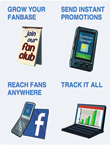 Fanminder is helping small businesses get social. For smaller operations in which employees are already filling multiple roles and every penny is pretty much spoken for, staying on top of social media can be next to impossible. That’s a dilemma that Fanminder, based in Los Altos, CA, hopes to solve. Fanminder, which launched in 2010, allows merchants and other small businesses to send instant promotions to their customers’ mobile phones, social networking pages, and email accounts. “We wanted to build the leading company completely dedicated to helping small businesses win with social and mobile marketing,” says cofounder and CEO, Paul Rosenfeld. “Fanminder helps the small business easily and affordably create and publish what we call instant promotions, that reach their fans anywhere.”
Fanminder is helping small businesses get social. For smaller operations in which employees are already filling multiple roles and every penny is pretty much spoken for, staying on top of social media can be next to impossible. That’s a dilemma that Fanminder, based in Los Altos, CA, hopes to solve. Fanminder, which launched in 2010, allows merchants and other small businesses to send instant promotions to their customers’ mobile phones, social networking pages, and email accounts. “We wanted to build the leading company completely dedicated to helping small businesses win with social and mobile marketing,” says cofounder and CEO, Paul Rosenfeld. “Fanminder helps the small business easily and affordably create and publish what we call instant promotions, that reach their fans anywhere.”
The company currently works with about 1,400 small businesses and has launched some 5,000 campaigns to date, says cofounder and COO, Tracy Grover. Fanminder offers a turnkey operation that typically takes just a few minutes to setup, and costs about $40 to $60 per month, she says, though the cost can rise to $150 monthly for companies with more than 400 mobile fans. To get started, the merchant heads to the Fanminder homepage and provides basic information like the company name and time zone. The next step is creating an offer, such as, “Buy one, get one free, if you come in during the next seven days,” that can be published on the retailer’s website or social media page. Next is letting customers know they can access the offer via their phones. For instance, the offer might say, “Enter your cell phone number here and receive a text message good for a free product.” The merchant also can upload artwork like the company’s logo or a map to the store.
Along with advertising the promotion via the web, merchants can print or order paper signs, table tents and posters from Fanminder, to market within their physical locations. In addition, once customers have given their okay, the merchant can send them text messages with different offers and promotions. About 85 percent of adults now have cell phones, and nearly three-quarters send or receive text messages, according to the Pew Research Center. Anyone who has spent time online should be able to follow the sequence of steps to create promotions and offers. “It’s designed for the lay person,” Rosenfeld says. “No integration to the merchant’s POS system is required,” he adds. In addition, each coupon has a code that’s unique and good only for a one time use, greatly reducing the risk of fraudulent transactions.
